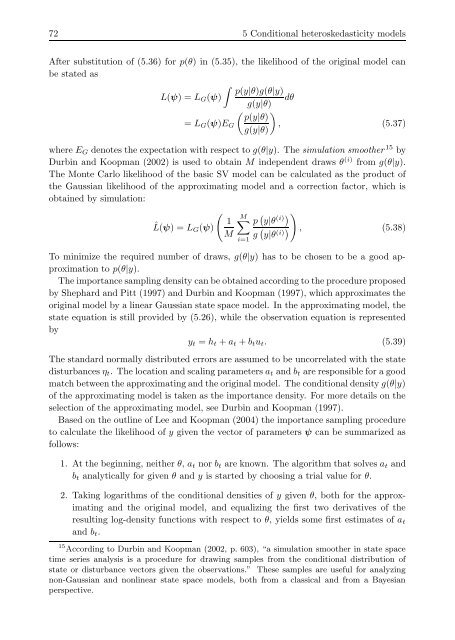Applications of state space models in finance
Applications of state space models in finance
Applications of state space models in finance
Create successful ePaper yourself
Turn your PDF publications into a flip-book with our unique Google optimized e-Paper software.
72 5 Conditional heteroskedasticity <strong>models</strong><br />
After substitution <strong>of</strong> (5.36) for p(θ) <strong>in</strong> (5.35), the likelihood <strong>of</strong> the orig<strong>in</strong>al model can<br />
be <strong>state</strong>d as<br />
�<br />
p(y|θ)g(θ|y)<br />
L(ψ) = LG(ψ)<br />
dθ<br />
g(y|θ)<br />
� �<br />
p(y|θ)<br />
= LG(ψ)EG , (5.37)<br />
g(y|θ)<br />
where EG denotes the expectation with respect to g(θ|y). The simulation smoother 15 by<br />
Durb<strong>in</strong> and Koopman (2002) is used to obta<strong>in</strong> M <strong>in</strong>dependent draws θ (i) from g(θ|y).<br />
The Monte Carlo likelihood <strong>of</strong> the basic SV model can be calculated as the product <strong>of</strong><br />
the Gaussian likelihood <strong>of</strong> the approximat<strong>in</strong>g model and a correction factor, which is<br />
obta<strong>in</strong>ed by simulation:<br />
�<br />
M�<br />
ˆL(ψ)<br />
1 p<br />
= LG(ψ)<br />
M<br />
� y|θ (i)�<br />
g � y|θ (i)�<br />
�<br />
, (5.38)<br />
To m<strong>in</strong>imize the required number <strong>of</strong> draws, g(θ|y) has to be chosen to be a good approximation<br />
to p(θ|y).<br />
The importance sampl<strong>in</strong>g density can be obta<strong>in</strong>ed accord<strong>in</strong>g to the procedure proposed<br />
by Shephard and Pitt (1997) and Durb<strong>in</strong> and Koopman (1997), which approximates the<br />
orig<strong>in</strong>al model by a l<strong>in</strong>ear Gaussian <strong>state</strong> <strong>space</strong> model. In the approximat<strong>in</strong>g model, the<br />
<strong>state</strong> equation is still provided by (5.26), while the observation equation is represented<br />
by<br />
yt = ht + at + btut. (5.39)<br />
The standard normally distributed errors are assumed to be uncorrelated with the <strong>state</strong><br />
disturbances ηt. The location and scal<strong>in</strong>g parameters at and bt are responsible for a good<br />
match between the approximat<strong>in</strong>g and the orig<strong>in</strong>al model. The conditional density g(θ|y)<br />
<strong>of</strong> the approximat<strong>in</strong>g model is taken as the importance density. For more details on the<br />
selection <strong>of</strong> the approximat<strong>in</strong>g model, see Durb<strong>in</strong> and Koopman (1997).<br />
Based on the outl<strong>in</strong>e <strong>of</strong> Lee and Koopman (2004) the importance sampl<strong>in</strong>g procedure<br />
to calculate the likelihood <strong>of</strong> y given the vector <strong>of</strong> parameters ψ can be summarized as<br />
follows:<br />
1. At the beg<strong>in</strong>n<strong>in</strong>g, neither θ, at nor bt are known. The algorithm that solves at and<br />
bt analytically for given θ and y is started by choos<strong>in</strong>g a trial value for θ.<br />
2. Tak<strong>in</strong>g logarithms <strong>of</strong> the conditional densities <strong>of</strong> y given θ, both for the approximat<strong>in</strong>g<br />
and the orig<strong>in</strong>al model, and equaliz<strong>in</strong>g the first two derivatives <strong>of</strong> the<br />
result<strong>in</strong>g log-density functions with respect to θ, yields some first estimates <strong>of</strong> at<br />
and bt.<br />
15 Accord<strong>in</strong>g to Durb<strong>in</strong> and Koopman (2002, p. 603), “a simulation smoother <strong>in</strong> <strong>state</strong> <strong>space</strong><br />
time series analysis is a procedure for draw<strong>in</strong>g samples from the conditional distribution <strong>of</strong><br />
<strong>state</strong> or disturbance vectors given the observations.” These samples are useful for analyz<strong>in</strong>g<br />
non-Gaussian and nonl<strong>in</strong>ear <strong>state</strong> <strong>space</strong> <strong>models</strong>, both from a classical and from a Bayesian<br />
perspective.<br />
i=1

















